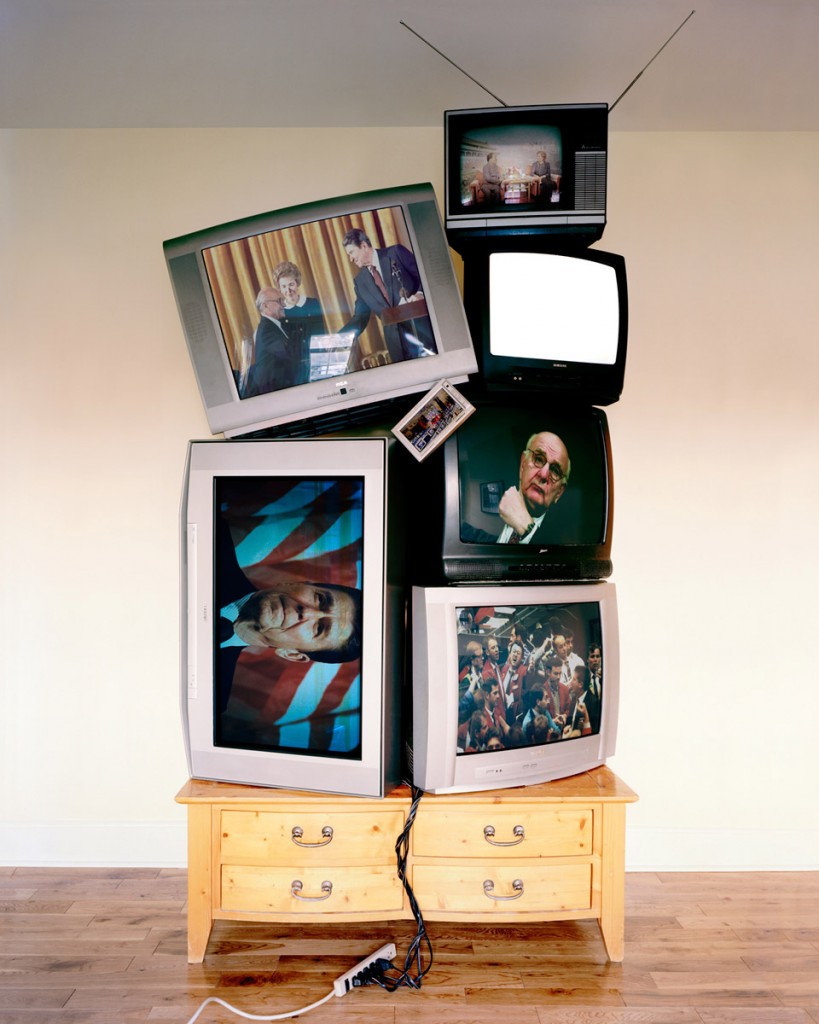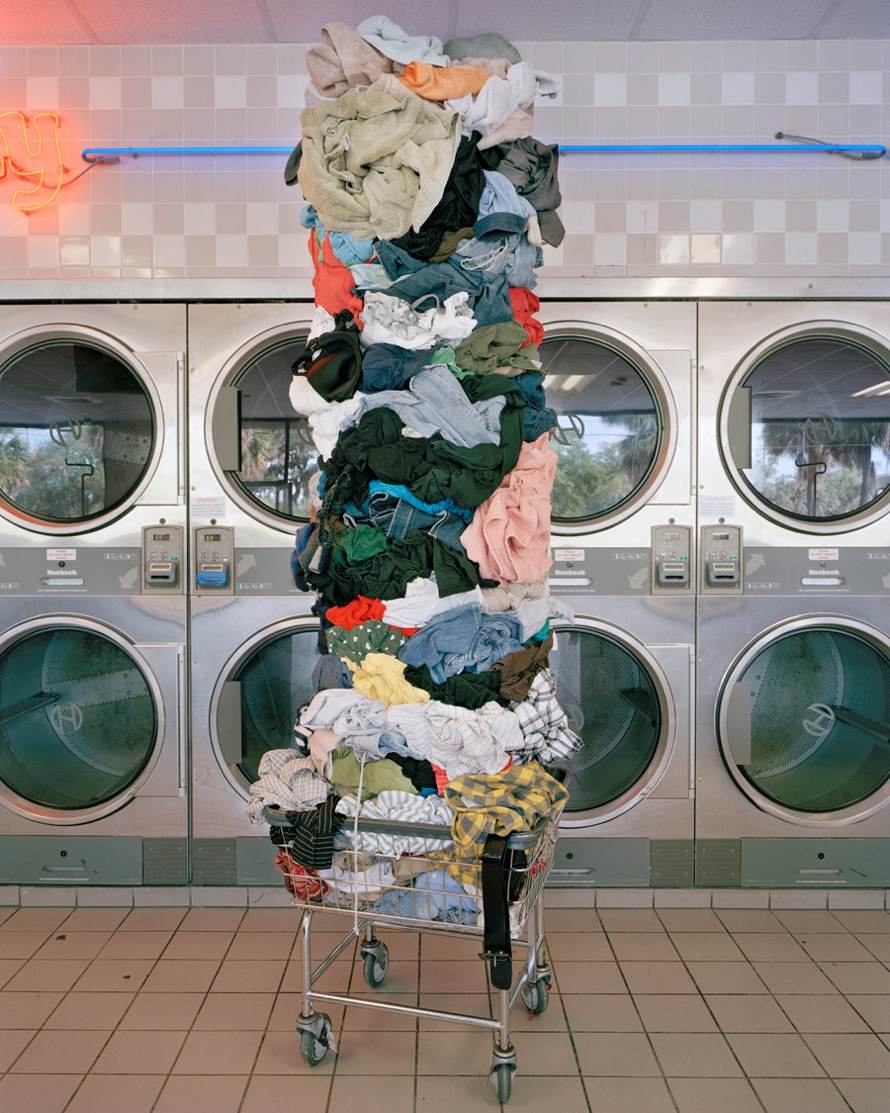David Welch is a fine art photographer based on the island of Martha’s Vineyard. His work explores social issues, using large-format photography steeped in conceptual influences from art history and economic theory. His work has been widely published and exhibited both nationally and abroad. David was a featured artist in issue N.1 of Aint-Bad Magazine. David was recently named one of the Magenta Foundation’s Flash Forward winners for 2012 and in 2011 he was selected as one of Photolucida’s Critical Mass top 50 photographers. David is a recent graduate of the Savannah College of Art and Design, where he earned his MFA in photography. He lives on the island with his partner Trina and daughter, Camden.
 Shopping Totem, 2010
Shopping Totem, 2010
Material World
It was Karl Marx’s belief that all of humanity started with nature. 2 Through contemplation, man enters a state of self-alienation, a transformative relationship between man and nature where man manifests his activity into a materially existing form that serves as a mirror of self-understanding, reflection and subsequent progression. According to Marx, “the object of labor is therefore the objectification of the species life of man: for man reproduces himself not only intellectually, in his consciousness, but actively and actually and he can therefore contemplate himself in a world he has created.”3 and according to contemporary Anthropologist Daniel Miller it is the way in which we “enhance our capacity as human beings.”4
 Neoliberal Totem, 2010
Neoliberal Totem, 2010
The problem with this understanding of Marxist theory is that it concentrates mostly on those production aspects of industrialization that might be considered too Romantic in contemporary terms. Objectification is a process where one produces, reflects and moves on—a marked progression. However, Marx argues that through our capitalistic industrial model, one where products are created through labor and then sold through the marketplace to individuals who do not create them causes a rupture in the progression process. Here one produces, but not for himself and his own mirror for self-understanding—in short, the producer does not necessarily own the fruits of his own labors. Further, most individuals do not own the means to their own objectification potential, a consequence of rampant industrialization. The means of production—the private ownership of tools and resources—rests in the hands of a small minority and the majority of individuals are “forced to attempt to objectify themselves through forms which are produced in the image of other people’s interests.”6 goods distributed to marketplaces.
 Laundry Totem, 2011
Laundry Totem, 2011
 Beer Can Totem, 2011
Beer Can Totem, 2011
 Plastic Totem, 2010
Plastic Totem, 2010
How then do we gather meaning from objects offered as consumer commodities? While the introduction to Marx’s Objectification sets a good foundation as to why goods are produced and demonstrates their progressive potential, if we are to look at our current system, what do these objects mean and how can the typical consumer interpret them? Here we revisit an earlier argument that introduced Gabriel and Lang’s notion of an implied meaning within consumer commodities. We can argue, from their view, that individual pursuits demonstrated by labor do not share any of the progressive benefits put forth by the theories of Objectification and its self- alienation.8 in their 1995 book The Unmanageable Consumer view, but presented as a more overtly contrasting standpoint of the nature-man duality claimed by Miller and Marx, is the writing of Jean Baudrillard. In his essay Consumer Society, he argues for a structured, semiotic approach to the interpretation of material objects within consumer societies, one treating objects as signs within a larger system of communication. To Baudrillard, consumption is a system of meaning, much like language.10 This suggests that what Baudrillard refers to, as the “ideal of conformity” through a “standard package” is actually a semiotic communication of status through the consumption and accumulation of particular goods made available to them.
 Toilet Paper Totem, 2011
Toilet Paper Totem, 2011
 Toy Totem, 2011
Toy Totem, 2011
The photographs in Material World take influence from this Marxist concept “Objectification”. It is rooted in the transformative relationship between humankind and nature where individuals manifest their activities into materially existing forms. For Marx, interpreted by Miller, these forms serve as mirrors for self-understanding through contemplation and reflection, progressive steps towards our enhanced capacity as human beings.
 Tire Totem, 2011
Tire Totem, 2011
Objects do have communicative abilities and we give them meaning, investing cultural significance, passing objects from a closed, silent existence to an oral state, like a system of language, where objects can communicate certain values. Here values replace needs and so much as we create objects, will their existence as cultural artifact show that they in fact created us?
 Car Culture Totem, 2011
Car Culture Totem, 2011
Material World is my response to our contemporary consumer milieu. By treating these artifacts of consumer culture as Duchampian-inspired Assisted Readymades, I photograph assemblages, constructed by my own hand to form monuments and totems that serve as precarious externalizations of culture and social biography. Modeling Marx’s concept, the photographs of the totems then act as symbolic mirrors, points of reflection for my own contemplative gaze and that of society’s. The photographs speak of accumulation and materiality and aim to encourage debate about consumption and the ways in which we feel compelled to consume.
Find more work on his website David Welch
Footnotes :
1.Daniel Miller, Stuff (Cambridge: Polity, 2010), 58.
2. Ibid. 59.
3. Self-alienation is a term borrowed from Hegel who originated the concept of Objectification within a similar context as Marx. Marx, however, viewed the term as a more appropriate way to understand man’s relationship with materiality and objects during more industrial times. Self-alienation is viewed as a positive and progressive step within Objectification.
4. Miller, Stuff. 59.
5.Daniel Miller, Material Culture and Mass Consumption (Oxford: Basil Blackwell, 1987), p 45.
6. The concept of aura as applied to objects originated with German intellectual Walter Benjamin. In the essay The Work of Art in the Age of Material Reproduction, Benjamin views the displacement of a worker’s fingerprint within objects through its mass production. This mass production mechanism destroys an objects aura by creating a “sense of universal equality of things.”
7. See footnote 3.
8. Martin Jaeggi, Thomas Seelig, and Stahel Urs. Seelig, Trade: Commodities, Communication, and Consciousness. (Zürich: Scalo, 2001), 67.
9. Jean Baudrillard and Mark Poster, “Consumer Society.” In Jean Baudrillard: selected writings, (Stanford, CA: Stanford University Press, 1988), 46.
10. Baudrillard and Poster, 37.